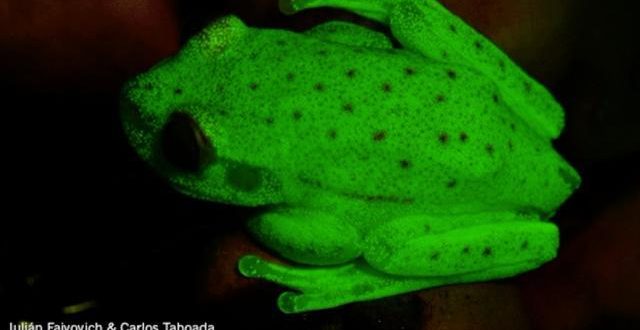Scientists have discovered a naturally fluorescent polka-dot tree frog in Amazon basin near Argentina. At first sight, the frog looks just another plain colored creature but it actually glows neon green when exposed to ultraviolent light. This makes it the world’s first amphibian with a remarkable ability to glow in dark.
According to a new report in the Proceedings of the National Academy of Sciences journal, the South American frog is the first known amphibian capable of fluorescence, which is the ability to absorb light at short wavelengths and send light back out at longer wavelengths.
In nature, fluorescence can be seen in a various ocean creatures, including corals, sharks and sea turtles. It can also be seen in land animals like scorpions and parrots. Incidentally, fluorescence is different from bioluminescence, which is the capacity to generate light via chemical reactions.
The study team said they first suspected H. punctatus might fluoresce when they discovered it had a particular skin pigment associated with the capability. When they directed a black light at it and discovered the frog transformed into a neon green frog. Astonished at their finding, the scientists executed a comprehensive investigation of the amphibian’s skin. By doing this, they uncovered three molecules, hyloin-L1, L2 and G1 that are unlike the other molecules known to cause fluorescence in other animals.
They also discovered the molecules released of a lot of light, with nearly one-fifth the power of moonlight. This should enough light for one frog to be seen by another. Unfortunately, researchers do not know much about the visual systems of H. punctatus, although they said they plan of studying it.
“I think it’s exciting,” marine biologist David Gruber, who was not among the study’s authors, told Scientific American. “It opens up many more questions than are answered,” he says — including the ecological and behavioral function of fluorescence.
The study team members said they plan to search for fluorescence in 250 other tree frogs that have similar, translucent skin.
“I’m really hoping that other colleagues will be very interested in this phenomenon, and they will start carrying a UV flashlight to the field,” said study author Julián Faivovich, a herpetologist with the American Museum of Natural History.
Agencies/Canadajournal
 Canada Journal – News of the World Articles and videos to bring you the biggest Canadian news stories from across the country every day
Canada Journal – News of the World Articles and videos to bring you the biggest Canadian news stories from across the country every day



